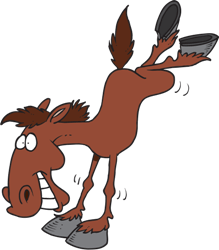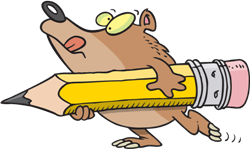Single Quotation Marks
Rules and Examples
 In the English language, we mainly use single quotation marks ( ' ' ) when
a quotation or a title is placed inside of another quotation.
In the English language, we mainly use single quotation marks ( ' ' ) when
a quotation or a title is placed inside of another quotation.Click Here for Step-by-Step Rules, Stories and Exercises to Practice All English Tenses
This lesson will discuss the differences of the uses of single quotation marks in American English and British English.
The correct order of quotation marks
In American English, we usually use double quotation marks ( " " ) first and single quotation marks ( ' ' ) second.Examples:
-
My mother said, "The baby started talking today. The baby
said, 'Mama.' "
- The teacher asked us, "How many of you have read the story 'The Brown Horse' in your textbook?"
In British English, we usually reverse the order of single and double quotation marks.
British English usually uses single quotation marks first and then double quotation marks.
Examples:
-
My mother said, 'The baby started talking today. The baby said, "Mama".'
-
The teacher asked us, 'How many of you have read the story "The Brown
Horse" in your textbook?'

On the keyboard
You can make single quotation marks on most computers by pressing the apostrophe/quotation mark key to the left of ENTER.Double quotation marks are made on most computers by holding SHIFT and pressing the apostrophe/quotation mark key to the left of ENTER.
Uses of single quotation marks in English
1. Use single quotation marks for a quotation or title (article, story, or poem) within a quotation.
Examples:
A) American English:
-
The author read a passage from her new book, "The night was cold and
dark. 'I feel scared,' said Jenny, as they headed into the haunted
house."
- " 'The Red Balloon' is my favorite story," my father said.
B) British English:
- The author read a passage from her new book, 'The night was cold and
dark. "I feel scared", said Jenny, as they headed into the haunted
house.'
- ' "The Red Balloon" is my favorite story', my father said.

2. Use quotation marks to highlight words or phrases that are not being used for their exact meaning.
These are also called scare quotes because these words and phrases are ironic, or being used in an unusual way.Examples:
A) In American English, we usually use double quotation marks for scare quotes.
-
The kids stayed "completely silent" through the entire concert.
(= The writer is saying that the kids were not quiet.) -
My brother shared his "wisdom" with me.
(= The writer does not think his brother's advice is wise.)
B) In British English, we usually use single quotation marks for scare quotes.
-
The kids stayed 'completely silent' through the entire concert.
- My brother shared his 'wisdom' with me.

3. We use quotation marks to show that a letter is being used as a letter or a word is used as a word.
Examples:
A) In American English, we use double quotation marks for this.
 What is the definition of "quotations"?
What is the definition of "quotations"?
- Capitalize the "A" in her name.
B) In British English, we use single quotation marks for this.
-
What is the definition of 'quotations'?
-
Capitalize the 'A' in her name.
Use a space between single quotation marks and double quotation
marks.
In both American English and British English, most people use a space
between the double and single quotation marks to avoid confusion.
American English Example:
-
Correct:
" 'The Red Balloon' is my favorite story," my father said. - Incorrect:
"'The Red Balloon' is my favorite story," my father said.
British English Example:
- Correct:
' "The Red Balloon" is my favorite story', my father said. - Incorrect:
'"The Red Balloon" is my favorite story', my father said.
How to place punctuation marks with quotation marks
A) In American English, periods and commas are always placed inside quotation marks even if it does not make sense.
Exclamation points and question marks with quotation marks follow logic in American English.
-
The boy said, "My mom told me, 'Do not forget to eat your vegetables.' "
(The period is placed inside all quotation marks.)  " 'The Zoo Animals' is my favorite poem to read," mom said.
" 'The Zoo Animals' is my favorite poem to read," mom said.
(The comma is placed inside the quotation marks.)- "Have you read the poem 'The Yellow Cat'?" the teacher asked.
(The question mark goes with the sentence in double quotations, so it goes inside the double quotation marks. It does not go inside the single quotation marks with the title of the poem.)
B) In British English, punctuation marks (commas, periods, exclamation points, and question marks) always follow logic.
-
The boy said, 'My mom told me, "Do not forget to eat your vegetables'."
(Place the period outside of the single quotation marks in British English because it goes with the quoted sentence.) - ' "The Zoo Animals" is my favorite poem to read', mom said.
(The comma is placed outside the quotation marks in British English.) -
'Have you read the poem "The Yellow Cat"?' the teacher asked.
(The question mark goes with the sentence in single quotations, so it goes inside the single quotation marks. It does not go inside the double quotation marks with the title of the poem.)
C) In American English and British English, semicolons and colons always go outside the quotation marks.
Examples in American English:
- My teacher stated, "I love the poem 'The Snow'; however, my favorite poem is 'Winter Dreams.' "
(The semicolon goes outside of the single quotation marks.) - These names start with a '"B": Barbara, Bill, Bonnie, and Ben.
(The colon goes outside of the double quotation marks.)
Examples in British English:
- My teacher stated, 'I love the poem "The Snow"; however, my favorite poem is "Winter Dreams" '.
(The semicolon goes outside of the double quotation marks.) - These names start with a 'B': Barbara, Bill, Bonnie, and Ben.
(The colon goes outside of the single quotation marks.)

Get Updates, Special Offers, and English Resources
Download your FREE GIFT (the first two chapters of
English Short Stories Book and Workbook)
as soon as you join!

By submitting your email, you consent to receiving updates and newsletters from us and to the sharing of your personal data with third parties for the purposes of sending you communications. We will not spam you. You can unsubscribe at any time. For more information, please see our privacy policy.





